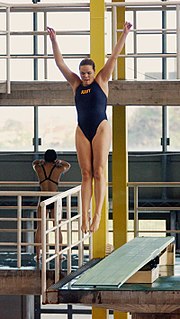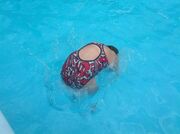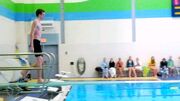Diving refers to the sport of performing acrobatics whilst jumping or falling into water from a platform or springboard of a certain height. Diving is an internationally-recognized sport that is part of the Olympic Games. In addition, unstructured and non-competitive diving is a common recreational pastime in places where swimming is popular.
While not a particularly popular participant sport, diving is one of the more popular Olympic sports with spectators. Successful competitors possess many of the same characteristics as gymnasts and competitive cheerleaders, including strength, flexibility, kinaesthetic judgment and air awareness.

Diving tower at the 2008 Euros
In the recent past, the success and prominence of Greg Louganis led to American strength internationally. More recently, the greatest diving nation has been China, which came to prominence several decades ago when the sport was revolutionized by national coach Liang Boxi and after intense study of the dominant Louganis. China has lost few world titles since. Other powers are generally those which import Chinese coaches, including Australia and Canada.
Diving was first introduced in the official programme of the Summer Olympic Games at the 1904 Games of St. Louis and has been an Olympic sport since. It was known as "fancy diving"[1] for the acrobatic stunts performed by divers during the dive (such as somersaults and twists). This discipline of Aquatics, along with swimming, synchronized swimming and water polo, is regulated and supervised by the International Swimming Federation (FINA), the international federation (IF) for aquatic sports.
Insights[]
Video Commercial about Greatness and Platform Diving being scary by Nike[]

Nike Find Your Greatness. — Diver
Nike ad: Find your greatness. A young diver on the 10-meter tower.
History[]
The first Olympic diving events were contested by men and consisted of a platform diving event ("fancy high diving") and also a plunge for distance event, which heralded victorious the diver who could reach the farthest underwater, while remaining motionless after a ground-level standing dive. At the 1908 Summer Olympics, men's springboard diving was added to the programme replacing the plunge for distance, regarded as uninteresting.[2] Women's diving debut happened at the 1912 Summer Olympics in the platform event and was expanded to springboard diving at the 1920 Summer Olympics. A parallel platform diving event for men, called "plain high diving", was presented at the Games of the V Olympiad. No acrobatic moves were allowed, only a simple straight dive off the platform.[3] It was last contested at the 1924 Summer Olympics after which it was merged with "fancy high diving" into one competition renamed "highboard diving" (or just "high diving").[4]
By the time of the 1996 Summer Olympics, the diving events were exactly the same as in 1928. However, four years later in Sydney, the inclusion of a synchronized diving variant for the springboard and platform events elevated the list up to eight events.
Competitive diving[]

Competitive Springboard Diving
Competitive Platform Diving
- http://hydrologicblog.com/springboard-diving/ Article about boards in pools.

GoPro Two Roads with Kristian Ipsen Ep. 2 - Diving
Diving and Other Sports[]
Divers do not consider themselves swimmers. While each sport shares a pool, and may compete side by side when doing so for their schools, the two sports are very different. Swimming is a full body exercise with emphasis on upper body strength and speed, diving is a full body exercise with emphasis on grace and execution; swimmers most frequently suffer overuse injuries, divers most frequently suffer impact injuries or strains.
The sister sport of diving is gymnastics. Many divers begin their training as gymnasts, and switch sports for one reason or another. Two of the most common are that they simply prefer diving, or that they develop a chronic injury that makes continuing gymnastics impossible. Gymnastics provides young divers with unique skills that help them perform complex and risky dives, but there are downsides; some habits developed in gymnastics can interfere with the correct technique of diving.
Governance[]
The global governing body of diving is FINA, which also governs swimming, synchronized swimming, water polo and open water swimming. Almost invariably, at national level, diving shares a governing body with the other aquatic sports.
This is frequently a source of political friction as the committees are naturally dominated by swimming officials who do not necessarily share or understand the concerns of the diving community. Divers often feel, for example, that they do not get adequate support over issues like the provision of facilities. Other areas of concern are the selection of personnel for the specialised Diving committees and for coaching and officiating at events, and the team selection for international competitions.
There are sometimes attempts to separate the governing body as a means to resolve these frustrations, but they are rarely successful. For example, in the UK the Great Britain Diving Federation was formed in 1992 with the intention of taking over the governance of Diving from the ASA (Amateur Swimming Association). Although it initially received widespread support from the diving community, the FINA requirement that international competitors had to be registered with their National Governing Body was a major factor in the abandonment of this ambition a few years later.
Since FINA refused to rescind recognition of the ASA as the British governing body for all aquatic sports including diving, this meant that the elite divers had to belong to ASA affiliated clubs in order to be eligible for selection to international competition.
In the United States scholastic diving is almost always part of the school’s swim team. Diving is a separate sport in Olympic and Club Diving. The NCAA will separate diving from swimming in special diving competitions after the swim season is completed.
Rules[]
- Wearing a swim cap and diving is a big deal for Canada (also known as CAN)
 's top divers in 2015. http://olympic.ca/2015/04/01/top-divers-face-competition-ban-after-cap-complaint/
's top divers in 2015. http://olympic.ca/2015/04/01/top-divers-face-competition-ban-after-cap-complaint/
Dive groups[]
There are six "groups" into which dives are classified: Forward, Back, Inward, Reverse, Twist, and Armstand. The latter applies only to Platform competitions, whereas the other five apply to both Springboard and Platform.
- In the Forward Group (Group 1), the diver takes off facing forwards and rotates forwards
- In the Back Group (2), the diver takes off with their back to the water and rotates backwards
- In the Reverse Group (3), the diver takes off facing forwards and rotates backwards
- In the Inward Group (4), the diver takes off with their back to the water and rotates forwards
- Any dive incorporating an axial twisting movement is in the Twist group (5).
- Any dive commencing from a handstand is in the Armstand group (6).(only on platform)
Dive positions[]
During the flight of the dive, one of the four positions may be specified:
- Straight - with no bend at the knees or hips
- Pike - with knees straight but a tight bend at the hips
- Tuck - body folded up in a tight ball, hands holding the shins and toes pointed.
- Free - Some sequence of the above positions.
These positions are referred to by the letters A, B,C and D respectively.
Dive numbers[]
In competition, the dives are referred to by a schematic system of three- or four-digit numbers. The letter to indicate the position is appended to the end of the number.
The first digit of the number indicates the dive group as defined above.
For groups 1 to 4, the number consists of three digits. The third digit represents the number of half-somersaults. The second one is either 0 or 1; with 1 signifying a "flying" variation of the basic movement: ie the first half somersault is performed in the straight position, and then the piked or tucked shape is assumed.
For example:
- 101A - Forward Dive Straight
- 203C - Back one-and-a-half somersaults, tuck
- 307c - Reverse three-and-a-half somersaults, tuck
- 113B - Flying forward one-and-a-half somersaults, pike
For Group 5, the dive number has 4 digits. The second one indicates the group (1-4) of the underlying movement; the third digit indicates the number of half-somersaults, and the fourth indicates the number of half-twists.
For example:
- 5211A - Back dive, half twist, straight position.
- 5337D - Reverse one and a half somersaults with three and a half twists, in the Free position.
For Group 6 - Armstand - the dive number has either three, four or five digits: Three digits for dives without twist and four for dives with twists.
In non-twisting armstand dives, the second digit indicates the direction of rotation (0 = no rotation, 1 = forward, 2 = backward, 3 = reverse, 4 = inward) and the third digit indicates the number of half-somersaults. Inward-rotating armstand dives have never been performed, and are generally regarded as physically impossible.
For example:
- 600A - Armstand dive straight
- 612B - Armstand forward somersault pike
- 624c - Armstand back double somersault tuck
For twisting Armstand dives, the dive number again has 4 digits, but rather than beginning with the number 5, the number 6 remains as the first digit, indicating that the "twister" will be performed form an Armstand. The second digit indicates the direction of rotation - as above, the third is the number of half-somersaults, and the fourth is the number of half-twists:
e.g. 6243D - armstand back double-somersault with one and a half twists in the free position
All of these dives come with DD (degree of difficulty) this is an indication of how difficult/complex a dive is. The score that the dive receives is multiplied by the DD (also known as tariff) to give the dive a final score. Before a diver competes they must decide on a "list" this is a number of optional dives and compulsory dives. The optionals come with a DD limit, this means that you must select X number of dives and the combined DD limit must be no more than the limit set by the competition/organisation etc.
Until the mid 1990s the tariff was decided by the FINA diving committee, and divers could only select from the range of dives in the published tariff table. Since then, the tariff is calculated by a formula based on various factors such as the number of twist and somersaults, the height, the group etc., and divers are free to submit new combinations.
Jumping off a 10-meter platform[]
Can be painful for days.

Extremely Painful High Dive Disaster
Film producer Chris Chapman trains to take on the ten metre diving board - only for things to go horribly wrong! Filmed in 2009. Produced and Directed by Chris Chapman; Camera - Simon Glass; Editor - Richard Alderson
Mechanics of diving[]
At the moment of take-off, two critical aspects of the dive are determined, and cannot subsequently be altered during the execution. One is the trajectory of the dive, and the other is the magnitude of the angular momentum.
The speed of rotation - and therefore the total amount of rotation - may be varied from moment to moment by changing the shape of the body, in accordance with the law of conservation of angular momentum.
The center of mass of the diver follows a parabolic path in free-fall under the influence of gravity (ignoring the effects of air resistance, which are negligible at the speeds involved).
Trajectory[]
Since the parabola is symmetrical, the travel away from the board as the diver passes it is twice the amount of the forward travel at the peak of the flight. Excessive forward distance to the entry point is penalized when scoring a dive, but obviously an adequate clearance from the diving board is essential on safety grounds.
The greatest possible height that can be achieved is desirable for several reasons:
- The height attained is itself one of the factors that the judges will reward.
- A greater height gives a longer flight time and therefore longer to execute the moves.
- For any given clearance when passing the board, the forward travel distance to the entry point will be less for a higher trajectory.
Control of rotation[]
The magnitude of angular momentum remains constant throughout the dive, but since
- angular momentum = rotational velocity × moment of inertia,
and the moment of inertia is larger when the body has an increased radius, the speed of rotation may be increased by moving the body into a compact shape, and reduced by opening out into a straight position.
Since the tucked shape is the most compact, it gives the most control over rotational speed, and dives in this position are easier to perform. Dives in the straight position are hardest, since there is almost no scope for altering the speed, so the angular momentum must be created at take-off with a very high degree of accuracy. (A small amount of control is available by moving the position of the arms and by a slight hollowing of the back).
Notice that the opening of the body for the entry does not stop the rotation, but merely slows it down. The vertical entry achieved by expert divers is largely an illusion created by starting the entry slightly short of vertical, so that the legs are vertical as they disappear beneath the surface. A small amount of additional tuning is available by 'entry save' techniques, whereby underwater movements of the upper body and arms against the viscosity of the water affect the position of the legs.
Twisting[]
Dives with multiple twists and somersaults are some of the most spectacular movements, as well as the most challenging to perform.
The rules state that twisting 'must not be generated manifestly on take-off'. Consequently, divers must use some of the somersaulting angular momentum To generate twisting movements.
Entry[]
The rules state that the body should be vertical, or nearly so, for entry. The arms must be beside the body for feet-first dives and extended forwards in line for "head-first" dives. It used to be common for the hands to be interlocked with the fingers extended towards the water, but a different technique has become favoured during the last few decades. Now the usual practice is for one hand to grasp the other with palms down to strike the water with a flat surface (the so-called "rip entry"). This creates a vacuum between the hands, arms and head which with a vertical entry will pull down and under any splash until deep enough to have minimal effect on the surface of the water. Once a diver is completely under the water they may choose to roll or scoop in the same direction their dive was rotating to pull the splash away from the channel which they have just created.
High Diving[]

Budapest, 2017 FINA High Diving location
American Diving[]
Divers can compete in several venues, which may may each have age and experience limitations.
USA Diving sanctions one East-West one and three meter event in the winter time with an Eastern champion and Western champion determined. In the summer USA Diving sanctions a national event with tower competitions offered.
AAU Diving sanctions one national event per year in the summer. AAU competes on the one, three, and tower to determine the All-American team. Ǎ
Most provincial level competitions consist of events for 6 different age groups (Groups A, B, C, D, E, and Open) for both genders on each of the three board levels. These age groups roughly correspond to those standardized by FINA, with the addition of a youngest age group for divers 9 and under, Group E, which does not compete nationally (although divers of this age may choose to compete Group D). The age group Open is so called because divers of any age, including over 18, may compete in these events, so long as their dives meet a minimum standard of difficulty.
Divers can qualify to compete at the age group national championships, or junior national championships, in their age groups as assigned by FINA up to the age of 18. This competition is held annually in July. Qualification is based on achieving minimum scores at earlier competitions in the season determined by DPC according to the results of the preceding year's national competition.
Divers older than 18, or advanced divers of younger ages, can qualify for the senior national championships, which are held twice each year, once roughly in March and once in June or July. Once again, qualification is based on achieving minimum scores at earlier competitions; in this case, within the 12 months preceding the national championships.
Famous divers[]
- Australia: Rebecca Gilmore, Mathew Helm, Chantelle Newbery, Robert Newbery, Dean Pullar, Melissa Wu, Matthew Mitcham, and Loudy Tourky
- Canada: Myriam Boileau, Philippe Comtois, Alexandre Despatie, Blythe Hartley, Émilie Heymans, Anne Montminy, Beverly Boys, and Irene MacDonald
- China: Fu Mingxia, Gao Min, Guo Jingjing, Hu Jia, Lao Lishi, Na Li, Li Ting, Wu Minxia, Peng Bo, Xue Sang, Tian Liang, Hailiang Xiao, Ni Xiong, He Chong and Yang Jinghui
- Holland: Edwin Jongejans
- Italy: Klaus Dibiasi, Giorgio Cagnotto, Tania Cagnotto
- Mexico: Rommel Pacheco,Fernando Platas
- Russia: Alexander Dobroskok, Vera Ilina, Igor Lukashin, Ioulia Pakhalina, and Dmitri Sautin
- United Kingdom: Leon Taylor, Peter Waterfield, Jason Statham, Tom Daley
- United States: Hobie Billingsley, Lesley Bush, Jennifer Chandler, Scott Donie, Michael Galitzen, Bruce Kimball, Micki King, Nathan Kohuth, Beatrice Kyle, Mark Lenzi, Greg Louganis, Pat McCormick, Cynthia Potter, Aileen Riggin, Laura Wilkinson

Promotion within a McDonalds in China (also known as CHN)  .
.
Summer Dreamers and Diving[]

Malik dives.

Jump or dive? Learning is not always so easy.

Kamaal at Homewood Pool with a running dive.

Dive word.

Dive from the side.

Diving only happens in the deep water. Never dive into shallow water or into water where the bottom depth is unsure. Diving can be dangerous.
Diving Videos[]
Fun[]

High Diving Giraffes
Varsity Diving is part of the Swimming & Diving Team[]

Varsit[y diver for Obama Academy, Tommy Brewton, setting a school record in a high school meet.
